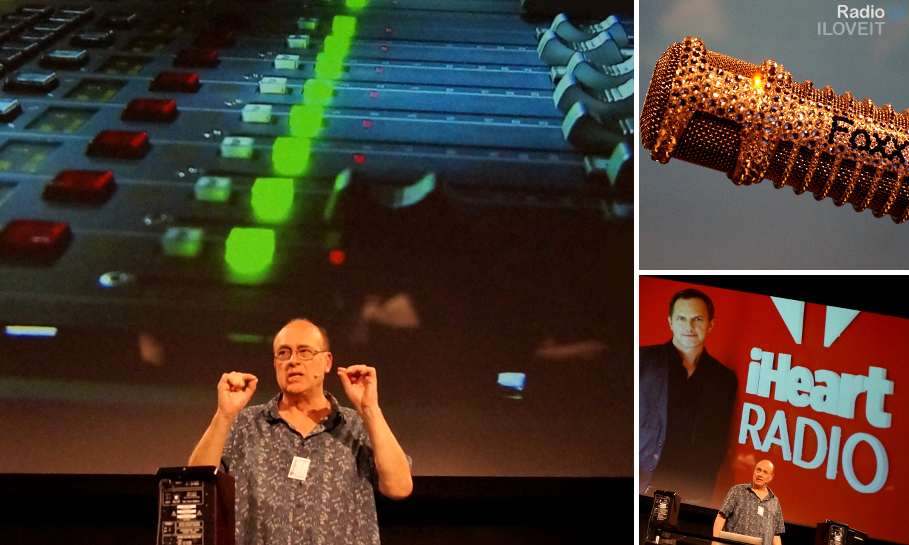Providing your voiceover talents with pristine copy will allow their performance (and your production) to touch the listener’s heart, radio imaging veteran Dave Foxx says.
Z100’s former Creative Service Director, Dave Foxx, produced a Most Requested Live promo live on stage at The Imaging Days 2016, where he provided radio imaging, voiceover & copywriting tips — including an idea for finding new ideas — and shared his number 1 radio copywriting advice when you’re writing scripts for a voice talent. “Make it a thousand percent easier for your VO talent to just connect with it emotionally, and not think about what you wrote.”
“I started working at a local station, and never looked back”

Dave Foxx acquired his copywriting, voiceover & production skills by doing (image: Thomas Giger)
Build your voiceover template
Exchanging The Big Apple for Austin, and the Z100 studios for his home gear, didn’t make his professional life less busy. Foxx continues doing voiceovers for stations worldwide, and weekly promos for the nationally syndicated Most Requested Live (for which he not only does VO, but handles the entire production). He created one of these spots on stage, building a promo shell with (due to echo in the session room) a preliminary voiceover that he could re-record & replace later, and using his standard Pro Tools voiceover & production template to make every production sound basically consistent. His routine looks systematic and efficient, aimed at getting maximum results in minimum time. After recording his VO (about a concert trip to a Twenty One Pilots performance) from a self-written script, he records a voice insert with a southern accent for contrast, done by a volunteer from the audience.
Make your promo flow
The next step is adding music & FX. “I start all my promos with an impact or noise, using effects to effect”, he says in reference to an earlier presentation where he explained ways to brand your work and make it recognisable. He first puts that signature starter sound in place. Then he creates all music work parts by choosing instrumental segments (usually from song intros) that are easily loopable to build a ramp on which the VO can ‘talk up’ to a song hook. In this case, the intro of Ride flows into the chorus of that song through a crossfade on the two-beat:
… going into another ramp, the intro of Stressed Out, through a crossfade on the one-beat:
… moving into a short hook part with a crossfade on the three-beat:
… and, after second hook from that song, transitioning into a musical outro for the promo’s final wordings. After adjusting audio levels and adding final processing, it sounds like this:
Grow your hands-on experience
Dave Foxx then opened his presentation to general Q&A, which I used as a chance to ask him:
How did you develop your voiceover skills over the years, and what tips can you give to production people who might be able to voice their own copy?
Before he come in touch with radio, he wanted to be an actor. “I studied under Karl Malden, who was in The Streets of San Fransisco, a wonderful actor. After about six months, I kind of got tired of the whole ‘acting stage scene’. Over the course of the next four years, I changed my major seven times. I went from marine biology to microbiology to political science to journalism, and finally to radio and television broadcast.” Based on his story, it seems important to get a lot of practical know-how (besides an educational foundation). “Once I started the broadcast course, I looked at everything in there, and said: I don’t need a degree in this; this is moronic. I started working at a local radio station, and never looked back. I went to school for seven years, and never got a degree.” Still, he’s learned a lot over the years: “What I do, is acting, and I take my cue from other actors a lot.” He was influenced by Z100’s first station voices Ernie Anderson and Keith Eubanks, as well as legend Don LaFontaine, and shares how he himself became the voice of Z100:
“Just read it the way that the emotion comes”

Dave Foxx had a Neumann M-149 in his Z100 studio, but is currently using this Electro Voice RE-20 ‘bling bling’ mic, a farewell gift from Elvis Duran, with a Shure X2U XLR-to-USB Signal Adapter for recording voiceovers at home or on the road (image: Thomas Giger)
Train your speech rhythm
Foxx answers my question in detail when he shares advice on how to become a station voice (or any kind of voice actor, for that matter). “The first thing you need to do, is take a class in dramatic arts and public speaking. Because that’s what you’re doing. When you close your eyes, with the mic in front of you, you’re speaking to — in my case, in the last several years — millions of people. But I don’t think about them; I just think about that one”, he says as a reference to his model listener ‘Mika’ for which he produced everything at Z100 (see part 1). Before getting any voice lessons, he would do two exercises. One is called stream of consciousness speaking. “Don’t do this with anyone else in the car; you’ll drive them absolute bonkers”, he jokes when explaining a technique where you observe what you see, and describe it out loud while you listen to yourself. “It gets you in the habit of listening to what you’re saying; not for the content, but for the rhythm. Rhythm is very important to what you do as a VO artist.”
Parrot your professional examples
The second exercise you can do on your own, before hiring a vocal coach, is again one to practice in private: “Turn on the television, or turn on the radio, and listen to somebody doing what you want to do, and parrot. So, when somebody says: ‘Your satisfaction guaranteed’, you say it right along behind them: ‘Your satisfaction guaranteed’. You have no idea what they’re going to say, usually, which requires you to think as you’re speaking; there’s a thought process going on. If you can do those two things; get your rhythm and your thought process as you’re doing VO, the rest becomes easy.”
Perfect your voiceover copy
Dave Foxx enjoys working with imaging directors who write copy that gets the best out of the voiceover. One of his clients in Europe told him: “I’ll be sitting there, typing, and I’ll hear your voice in my head as I write these words. I’ll send it to you, and it will come back perfect every time.” He says that when you expect something specific from a VO artist, make sure that it’s pristine in every way, from excellent grammar to uniform layout, so your voice talent doesn’t have to guess about anything. In his experience, it leads to much better takes, as talents “don’t have to think about ‘what do they mean by writing this?’; they just read it the way that the emotion comes. They’re not thinking about the technical part; they’re thinking about the emotional part, and that’s exactly what you want.” That leads to his number 1 tip for great radio copywriting for voiceovers, especially if you’re not the VO yourself.
“That one voice is speaking to other people”

Dave Foxx says your copy should allow your VO to communicate emotion (image: Thomas Giger)
Write your copy responsive
Foxx’ advice is to make your copy a dialogue for one, instead of a monologue. “There’s only one voice, so you would think that’s monologue. No, because that one voice is speaking to other people. You have to assume certain responses. You have to write carefully to make sure they ask the right questions; give the right pictures; give the right emotions, so it’s easy to predict what the response will be. If you’re writing for someone else to read and you’re writing dialogue for one, it becomes easy for them to figure out what you’re looking for. They’ll get into the rhythm of it, instead of worrying about ‘what do they mean?’ or ‘why isn’t there a period at the end of this sentence??!’. Be careful with your punctuation; your grammar; your font size; everything. It will make it a thousand percent easier for your VO talent to just connect with it emotionally; not think about what you wrote. In everything we do, emotions are the key.” In closing, he points out there are many ways of doing things. His way is just one way. He encourages us to take (parts of) his and other people’s ideas, and combine those (with own inspiration) into new concepts. That’s what creativity is:






Add Your Comment